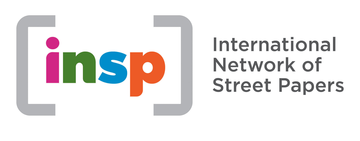 |
| David Burnett talks to the street paper vendors. Photo: Sebastian Stange/ Photographers For Hope |
"I was just a kid, wandering my way through, figuring things out," remembers David Burnett of his first job: an internship at Time magazine. "It was a hell of a lot of fun. I was not a great photographer, but I got a little better while I was there. You don't have to be the star the first week you're taking pictures. You just have to work hard and get to the point you're putting everything you've got into your pictures. It's not like a chemistry class where you can learn it; you just have to feel it. That takes a little while to get in touch with."
Burnett has been putting everything to his pictures for more than forty years. The world-renowned snapper has worked in more than 80 countries; captured revolutions in Iran and Chile; borne witness to famine in Ethiopia; covered every US presidential election since 1976 and every Olympic Games since 1984. Starting his own New York agency in the mid-seventies, Burnett has forged his own way of working on magazine assignments, keen to experiment wherever possible and unhampered by the demands of working for a wire service or daily newspapers.
Photographers for Hope
The American photographer's latest project sees him in Glasgow, working with Big Issue vendors to help them capture their daily experiences in photos and film. At workshop sessions in the city, Burnett and his team from the charity collective Photographers for Hope have been guiding six novices through the medium. Organised by Glasgow-based charity the International Network of Street Papers (INSP), an exhibition of the photographs by both street paper vendors and professional photographers will be launched at BBC Scotland's HQ this Thursday.
"We're working with the vendors so they can show what their lives are like, using photography as a tool to do that," explains Burnett. "It's exciting. It's about giving people who haven't had much experience of photography the chance to see if it's something that clicks a button for them. We're trying to open people up to photography. Some folks get it quickly; some can spend days and days and they don't. Some people are just born with a bit of an artistic sensibility. But even if you're not, that's OK. The great thing about photography is you don't need to be licensed to do it; you can just pick up the camera and go."
 |
| Street paper vendor Malky Dunn shooting pictures off Buchanan street, in Glasgow. Photo: David Burnett/ Photographers For Hope |
Burnett can remember his own first "colour assignment" - shooting the history-making launch of Apollo XI in Florida for Time. His images of expected, hopeful crowds gazing skyward have become an indelible part of how America remembers its first moon shot. "I wouldn't say I was a great photographer then," he says modestly. "There were just cool things going on to capture. The Apollo launch was one of those things you look back and you think that's something I'm glad I was able to do. Every place I went to I learned something, whether it was photographic, or cultural. One of the great joys of being a photographer this long is having had so many adventures."
Vietnam
In 1971, aged just 24, Burnett was sent by the weekly news magazine to cover America's gruesome adventures in Vietnam. He returned with remarkable pictures. The photo of an exhausted young soldier reading a letter near the Laos border remains one of the war's most haunting images. "I learned quite a bit from Vietnam," he says. "There were a lot of people I learned from when I was there, including a Welsh photographer, Philip Jones Griffiths, and some of the most interesting reporters were from the UK. You watch others and you think, 'Well that's a little more interesting that what I'm doing'. There's something to be said for paying attention to your elders.
"But actually, I also love watching and learning from what the kids do these days, because they are not encumbered by the same obstacles. Someone of my generation might think 'you can't do this' or 'you can't do that'. I still want to figure out what these kids are doing, and put my own little twist on it. You can't ever stop learning. You have to keep your eyes open all the time."
 |
| Big Issue Vendor Joan taking pictures during the workshop.Photo: Matteo Cardin/ Photographers for Hope |
"Sometimes the most telling pictures are in the least likely places. Maybe you find a guy in the street holding a sign rather than the politician. The guy in the street might tell you more of what's going on than the guy making the speeches and running for office."
"Eyes of the Street" is funded by The Big Lottery Awards for All Fund, the Scottish Community Foundation, Yorkshire and Clydesdale Bank Foundation and the Russell Trust. The cameras and memory cards used during the project were donated by Canon and ScanDisk.
The photography exhibition “Eyes of the Street” will be in the foyer of the Mitchell Library in Glasgow from July 23rd - August 31st. Entry is free and the photographs will be sold via a silent auction. Money raised will help the Glasgow-based charity International Network of Street Papers to support street papers –like The Big Issue- in 40 countries. So far, 200,000 vendors around the world have earned a living and changed their lives through selling INSP street papers.
